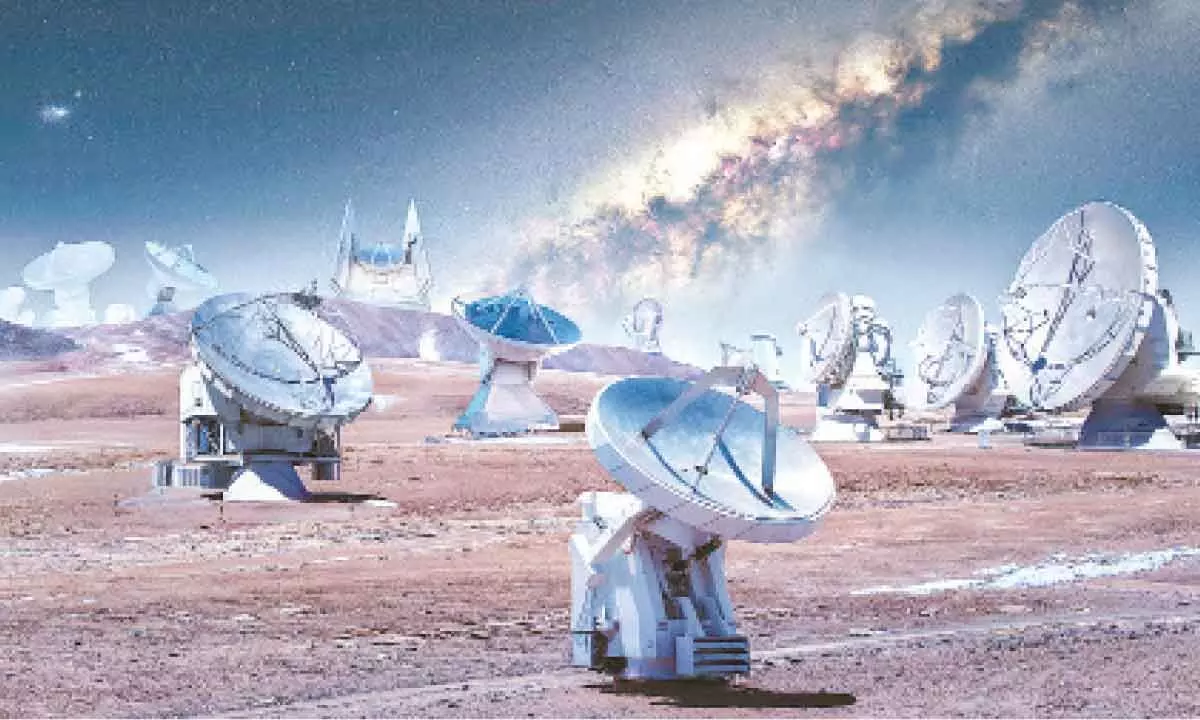Live
- Additional Collector Conducts Surprise Visit to Boys' Hostel in Wanaparthy
- Punjab hikes maximum state-agreed price for sugarcane, highest in country
- Centre okays PAN 2.0 project worth Rs 1,435 crore to transform taxpayer registration
- Punjab minister opens development projects of Rs 120 crore in Ludhiana
- Cabinet approves Atal Innovation Mission 2.0 with Rs 2,750 crore outlay
- Centre okays Rs 3,689cr investment for 2 hydro electric projects in Arunachal
- IPL 2025 Auction: 13-year-old Vaibhav Suryavanshi becomes youngest player to be signed in tournament's history
- About 62 lakh foreign tourists arrived in India in 8 months this year: Govt
- IPL 2025 Auction: Gujarat bag Sherfane Rutherford for Rs 2.60 cr; Kolkata grab Manish Pandey for Rs 75 lakh
- Assam CM meets Governor, cabinet expansion on the cards
Just In
Joining hands to explore universe


A unique collaboration using a virtual Earth-sized telescope shows how science is changing in the 21st century
In 2019, the Event Horizon Telescope (EHT) collaboration produced the first-ever image of a black hole, stunning the world. Now, scientists are taking it further. The next generation Event Horizon Telescope (ngEHT) collaboration aims to create high-quality videos of black holes. But this next-generation collaboration is groundbreaking in other ways, too. It's the first large physics collaboration bringing together perspectives from natural sciences, social sciences and the humanities.
A virtual telescope spanning planet
The larger a telescope, the better it is at seeing things that look tiny from far away. To produce black hole images, we need a telescope almost the size of Earth itself. That's why the EHT uses many telescopes and telescope arrays scattered across the globe to form a single, virtual Earth-sized telescope. This is known as very long baseline interferometry. Harvard astrophysicist ShepDoeleman, the founding director of the EHT, has likened this kind of astronomy to using a broken mirror.
The 2019 first-ever image of a black hole was made by borrowing existing telescopes at six sites. Now, new telescopes at new sites are being built to better fill in the gaps of the broken mirror. The collaboration is currently in the process of selecting optimal places across the world, to increase the number of sites to approximately 20. This ambitious endeavour needs over 300 experts organised into three technical working groups and eight science working groups.
The history, philosophy and culture working group has just published a landmark report outlining how humanities and social science scholars can work with astrophysicists and engineers from the first stages of a project. The report has four focus areas: collaborative knowledge formation, philosophical foundations, algorithms and visualisation, and responsible telescope siting.
How can we all collaborate?
If you've ever tried to write a paper (or anything!) with someone else, you know how difficult it can be. Now imagine trying to write a scientific paper with over 300 people. Should one expect each author to believe and be willing to defend every part of the paper and its conclusions? How should we all determine what will be included? If everyone has to agree with what is included, will this result in only publishing conservative, watered-down results? And how do you allow for individual creativity and boundary-pushing science (especially when you are attempting to be the first to capture something)? To resolve such questions, it's important to balance collaborative approaches and structure everyone's involvement in a way that promotes consensus, but also allows people to express dissent.
How do we visualise data?
The aesthetic choices regarding the final black hole images and videos take place in a broader context of visual culture. In reality, blue flames are hotter than flames appearing orange or yellow. But in the above false-colour image of Sagittarius A* – the black hole at the centre of the Milky Way – the colour palette of orange-red hues was chosen as it was believed orange would communicate to wider audiences just how hot the glowing material around the black hole is.
This approach connects to historical practices of technology-assisted scientific images, such as those by Galileo, Robert Hooke, and Johannes Hevelius.
These scientists combined their early telescopic and microscopic images with artistic techniques so they would be legible to non-specialist audiences (particularly those who did not have access to the relevant instruments).
Responsible tele siting
The choice of locations for telescopes, or telescope siting, has historically been determined by technical and economic considerations – including weather, atmospheric clarity, accessibility and costs.
There has been a historic lack of consideration for local communities, including First Nations peoples. As the struggle at Mauna Kea in Hawai'i highlights, scientific collaborations are obligated to address ethical, social and environmental considerations when siting. The ngEHT aims to advance responsible siting practices. It draws together experts in philosophy, history, sociology, community advocacy, science, and engineering to contribute to the decision-making process in ways that include cultural, social and environmental factors when choosing a new telescope location. Overall, this collaboration is an exciting example of how ambitious plans demand innovative approaches – and how sciences are evolving in the 21st century.
(Ritson works at The University of Melbourne and Marens at Utrecht University)

© 2024 Hyderabad Media House Limited/The Hans India. All rights reserved. Powered by hocalwire.com






